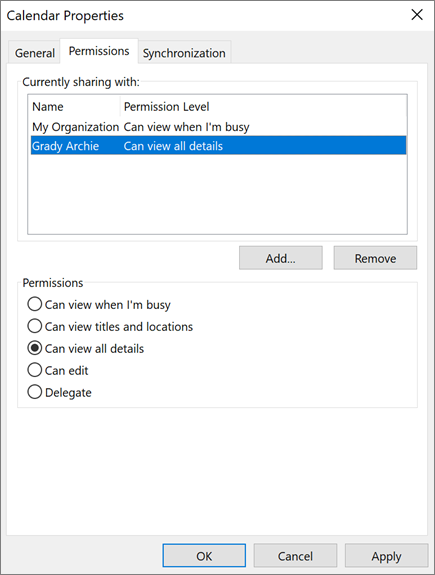What if you wanted to keep your next secret rendezvous under wraps?
When sharing your Outlook calendar with others, it's essential to properly configure the visibility of your events to avoid any slip-ups.
No worries!
I'm here to explain everything in detail.
What is visibility in Outlook Calendar?
Visibility means that your calendar is already shared with others, making it viewable to them. This can happen in two main ways:
- A personal calendar that you fully manage and choose to share with others.
- A work calendar within your organization, where colleagues can view it by default based on your organization's settings.
The good news is that you can control what others see about specific events, adjusting the level of detail shared based on your needs.
Visibility when my Outlook Calendar is managed by my company
🧠 Better avoid putting your next secret rendezvous here!
Internal company policies and the features of Microsoft Exchange or Office 365 impose certain restrictions, and users can't change the visibility settings defined by administrators.
You always have the right to mark an event as "Private," which hides sensitive details while still showing your colleagues that you are busy.
💡 A little tip: People with whom you share your work calendar can only accept your invitation if they have an Outlook.com or Microsoft 365 account. Sorry, Gmail users. This reignites the Outlook Calendar vs Google Calendar debate!
Visibility when sharing my personal calendar
There’s no major difference if you're subscribed to Microsoft 365 or using the standalone Outlook app.

The first scenario is that you share your calendar with specific people, who can add it directly to their own Calendar view in Outlook. There are different sharing permissions, which we’ll cover shortly.
The second scenario is that you make your calendar public. You send people a link to your calendar. This means anyone can see your calendar, not just people you’ve chosen!
💡 A little tip: Anyone with this link can view your calendar, even if they don't have an Outlook or Microsoft account.
How to choose the right calendar sharing settings?

Calendar shared via a public link
Let’s be clear: this is not the calendar to jot down personal information!
If you make your Outlook calendar public, anyone with the link can see all the details of your events without any restriction.
❓ How to make my Outlook calendar visible to everyone?
By default, your Outlook calendar is private. To make it public, you need to modify the sharing settings to allow "Everyone" access.
- Select Settings, then Calendar and Shared Calendars.
- Under Publish a calendar, choose the calendar you want to publish and how much detail users can see.
- Select Publish.
❓ Can I cancel the publication of a calendar?
Of course! Follow the same steps and select Unpublish.
Private calendar shared with specific people
When your Outlook calendar is private, only people to whom you grant specific permissions can access it.
You have five levels of permissions to choose from:
- Can view when I’m busy.
- Can view titles and locations.
- Can view all details.
- Can edit.
- Can edit and share.
💡 A little tip: These permissions may have different names depending on the version of Outlook you're using. Advanced permissions, like editing and sharing, are more commonly available in desktop or web versions for professional accounts.
A professional’s insight: managing visibility with multiple calendars
The limit of Outlook Calendar
What’s great about Outlook Calendar is its ability to manage multiple calendars within the same Microsoft account. This is especially useful for professionals working on different projects, collaborating with several organizations, or simply separating work and personal life.
However, it doesn't prevent calendar conflicts since they aren’t synced together.
Example: If you’re invited to a meeting on your Calendar A, there’s a risk of double-booking with an appointment scheduled at the same time on Calendar B.
The solution: SyncThemCalendars
To customize your syncs and effectively manage multiple calendars at the same time, SyncThemCalendars is the ideal tool.
A common use case: you're a business owner with your own personal Outlook calendar, and you also work for an organization that provides you with an Office 365 account. You now have two distinct Outlook calendars. You need each event in your personal calendar to appear in your professional calendar to avoid scheduling conflicts.
With SyncThemCalendars, you can easily set up a sync between a source calendar and a target calendar, adjusting a variety of settings so the synchronization fits your exact needs.
You have control over 7 parameters to determine precisely how a source calendar event appears in your target calendar:
- Summary: the name of the event.
- Description: the field to add details.
- Location
- Visibility: identifies whether an event is public or private.
- Availability
- Reminder
- Color
To manage what is visible or hidden in your target calendar, three settings are essential: Summary, Description, and Visibility.
Example: In your personal calendar, you’ve scheduled a confidential meeting. You want this appointment to appear in your professional calendar to avoid colleagues scheduling meetings at the same time, but you don’t want them to know the reason for the appointment.
We’ve got the solution!
Our method in 3 steps:
- Create your detailed appointment in your personal calendar (source calendar).
- Use SyncThemCalendars to make the event appear differently in your professional calendar (target calendar).
- Done!

Conclusion
To manage your sharing settings when dealing with multiple calendars, use a third-party tool like SyncThemCalendars, which compensates for Outlook Calendar's shortcomings.
Try our synchronization tool here and see the difference!
Oh, and if you ever need a mail tracking tool, we’ve got you covered too.


